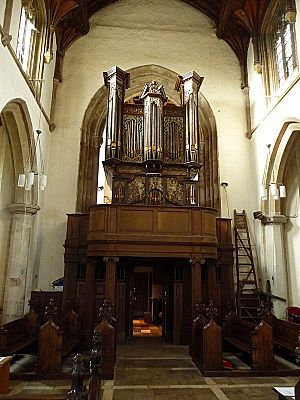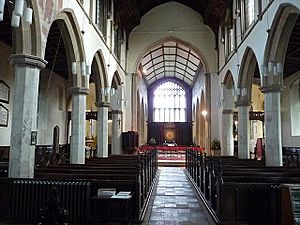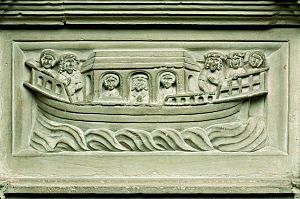St Michael the Archangel's Church, Framlingham facts for kids
Quick facts for kids St Michael’s Church Framlingham |
|
|---|---|
 |
|
| Country | England |
| Denomination | Church of England |
| Previous denomination | Roman Catholic |
| Churchmanship | Broad Church |
| Website | https://www.stmichaelsframlingham.org.uk |
| History | |
| Dedication | Saint Michael |
| Specifications | |
| Bells | 8 |
| Tenor bell weight | 16 long cwt 0 qr 14 lb (1,806 lb or 819 kg) |
| Administration | |
| Parish | Framlingham, Suffolk |
| Diocese | St Edmundsbury & Ipswich |
| Province | Canterbury |
St Michael's Church in Framlingham, Suffolk, is a special Church of England building. It is named after Saint Michael. This church is famous as the burial place for many members of the important Howard family. In 1966, it was officially recognized as a Grade I listed building. This means it is a very important historical building.
Contents
History of St Michael's Church
The Church of Saint Michael in Framlingham has been built and changed many times. Some parts, like the decorated tops of the chancel arch, are from the 1100s. But most of the church was built in a style called Perpendicular Gothic. This happened between 1350 and 1555.
The church roof is very beautiful. It has fancy patterns called fan tracery. These patterns hide the strong wooden beams that support the roof. This amazing roof was built around 1521.
Framlingham was once a main home for powerful families like the Earls and Dukes of Norfolk. Over time, the land changed owners many times. Around 1635, a man named Sir Robert Hitcham gave the Framlingham estate to Pembroke College, Cambridge. This college still owns the land today. The church has many important tombs. These include the tomb of Thomas Howard, 3rd Duke of Norfolk and his wife Anne of York.
Church Bells
St Michael's Church has a set of 8 bells. These bells were made by different people over many years. Some are from the 1400s, and others are from the 1900s. In 1718, two new smaller bells were added. This made the total number of bells eight.
The bells hang in a strong oak frame. This frame was built in 1892. In 1990, the bells were checked and repaired by experts.
| Bell | Date | Note | Diameter | Founder | Weight | ||
|---|---|---|---|---|---|---|---|
| long measure | lb | kg | |||||
| Treble | 1718 | E | 26.50 in (67.3 cm) | John Stephens | 4 long cwt 0 qr 18 lb | 466 | 211 |
| 2nd | 1718 | D# | 28.75 in (73.0 cm) | John Stephens | 4 long cwt 1 qr 6 lb | 482 | 219 |
| 3rd | 1720 | C# | 30.50 in (77.5 cm) | John Stephens | 5 long cwt 0 qr 20 lb | 580 | 263 |
| 4th | c1499 | B | 31.50 in (80.0 cm) | Brasyers of Norwich | 5 long cwt 2 qr 5 lb | 621 | 282 |
| 5th | c1499 | A | 34.00 in (86.4 cm) | Brasyers of Norwich | 6 long cwt 3 qr 18 lb | 774 | 351 |
| 6th | 1583 | G# | 37.25 in (94.6 cm) | William Brend | 8 long cwt 0 qr 16 lb | 912 | 414 |
| 7th | 1622 | F# | 42.25 in (107.3 cm) | William & John II Brend | 12 long cwt 1 qr 18 lb | 1,390 | 630 |
| Tenor | 1902 | E | 46.88 in (119.1 cm) | Mears & Stainbank | 16 long cwt 0 qr 14 lb | 1,806 | 819 |
The Famous Thamar Organ
One of the most famous things in the church is the Thamar organ. It is known all over the world. Only a few large organs survived the English Civil War. The Thamar organ is one of only three organs made by Thomas Thamar that are still around. The other two are in Gloucester Cathedral and St Nicholas's church.
The front pipes of the organ are painted. These pipes belong to the Thamar organ. It was first built in 1674 for Pembroke College, Cambridge. The organ's wooden case might be even older, perhaps from before 1630. Some of its pipes might also be very old.
In 1707, Pembroke College wanted a newer, bigger organ. So, the Thamar organ was moved to St Michael's Church in 1708. It was placed on a special platform called a gallery. It stayed there until 1898. For a while, the organ was moved around the church. But in 1970, the gallery was brought back. The organ was put back in its original place on the gallery.
The organ has been worked on by famous builders. In 1740, John Byfield worked on it. In 1898, another builder named Hunter rebuilt parts of it. He used most of the original Thamar pipes.
The organ was carefully restored in 1970. Experts made sure no new parts were added or taken away. A missing part, called the cornet, was found in the Rectory attic. It was fixed and put back. Old trumpet pipes were found to replace lost ones. The organ now sounds wonderful and is a very important part of the church.
Famous musicians have connections to this organ. It is believed that Felix Mendelssohn, a famous composer, gave music lessons here. He knew the father of the church's rector, who was also a composer and organist.
Howard Family Tombs
St Michael's Church holds the tombs of many members of the Howard family. Most of these tombs were moved here after the Dissolution of the Monasteries. This was when many monasteries were closed down.
Tomb of Henry FitzRoy, Duke of Richmond
Henry FitzRoy, Duke of Richmond and Somerset (1519–1536) is buried in this church. He was the son of Henry VIII. His tomb is very fancy.
The Duke of Richmond died in 1536. He was first buried somewhere else. Even though he was not born in a royal marriage, King Henry VIII gave him important titles. This was because Henry FitzRoy was the King's only son who lived past a few days. The 3rd Duke of Norfolk arranged for his daughter, Mary, to marry FitzRoy. They were married but were too young to live together. FitzRoy died at age 17 from an illness. The Duke of Norfolk was in charge of his burial. After the monasteries were closed, FitzRoy's tomb was moved to Framlingham. Mary FitzRoy was also buried here after she died in 1557.
Tomb of Thomas Howard, 3rd Duke of Norfolk
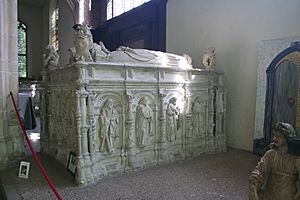
The tomb of Thomas Howard is next to the main altar. It is a very important historical artwork. The tomb has carvings of the twelve Apostles and some old Christian saints. These carvings show religious art from England before big changes happened during the Reformation.
The design of the tomb is a mix of French and English styles. It was made for the most powerful nobleman in England at that time. Some parts of this tomb might have been used in another tomb before. This other tomb was for Thomas Howard, 2nd Duke of Norfolk. It is thought that two other male bodies are buried in the 3rd Duke's tomb. People believe these might be his father and grandfather. They were likely moved to Framlingham after the monasteries were closed.
Tombs of the Wives of Thomas Howard, 4th Duke of Norfolk
The 4th Duke of Norfolk is buried in London. His wives, Mary FitzAlan and Margaret Audley, are shown on this tomb. They are wearing their fancy robes. Only Margaret is buried here. The space between their statues was likely meant for the Duke himself. The sides of the tomb show their family symbols. It seems there were once columns that held a canopy over the monument. This would have made it look even grander.
Tomb of Henry Howard, Earl of Surrey
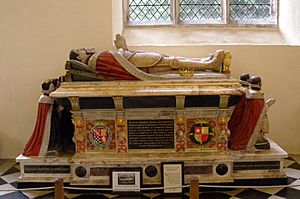
Before he died in 1614, Henry Howard, 1st Earl of Northampton arranged for his parents' remains to be moved to Framlingham. This monument was built in 1614 to show both of them. The writing on the tomb says that Surrey was the son of the Second Duke.
The tomb chest is not religious. Instead, it praises the good qualities of the people it honors. Surrey's two sons are kneeling at the foot of the tomb. At the head of the tomb are Howard's three daughters:
- Jane, who wears a small crown.
- Katherine Howard, who married Henry Berkeley, 7th Baron Berkeley.
- Margaret, who married Henry Scrope, 9th Baron Scrope of Bolton (1534–1592).
Around 1976, the middle of the monument was sinking. Experts worked to clean and fix it. During the cleaning, they found holes where a small crown once was. A new crown was made and placed on the tomb.
St Michael's Church in Fiction
St Michael's Church is one of the places in Framlingham that appears in a mystery book. The book is called Magpie Murders by Anthony Horowitz.
See also
 In Spanish: Iglesia de San Miguel Arcángel (Framlingham) para niños
In Spanish: Iglesia de San Miguel Arcángel (Framlingham) para niños


